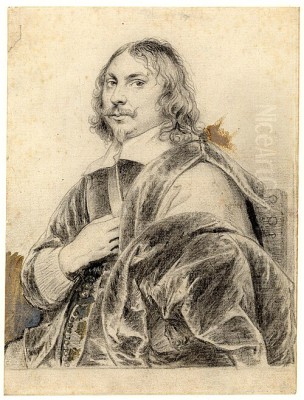
Jan Davidsz. de Heem stands as a towering figure in the art history of the Dutch Golden Age, celebrated primarily for his exquisite and opulent still life paintings. Born in Utrecht on April 17, 1606, and passing away in Antwerp before April 26, 1684, his life and career bridged the artistic worlds of the Northern and Southern Netherlands. De Heem's meticulous technique, vibrant palettes, and complex compositions earned him immense popularity during his lifetime and secured his legacy as one of the most influential still life painters of the 17th century. His work not only captured the material wealth and aesthetic tastes of the era but also often embedded subtle moral and symbolic meanings.
Early Life and Artistic Formation
Jan Davidsz. de Heem was born Johannes van Antwerpen into a Catholic family in the Dutch city of Utrecht. His father, David Janszoon van Antwerpen, was a carpenter who had moved with his wife, Hillegond Theunisdrison, to Utrecht around 1603. Despite his father and uncle being artisans (carpenters), the family background was relatively modest, offering little hint of the artistic heights Jan Davidsz. would later achieve. Some sources present conflicting information regarding his early years, but the consensus points to his birth in Utrecht in 1606.
His initial artistic training likely began under his father, Jan Davidszoon de Heem the Elder, though details remain scarce. More definitively, De Heem's formal training commenced in Utrecht, possibly under the guidance of Balthasar van der Ast, a prominent still life painter known for his delicate arrangements of flowers and shells. Van der Ast's influence is discernible in De Heem's early works, particularly in the choice of subject matter and the careful rendering of textures.
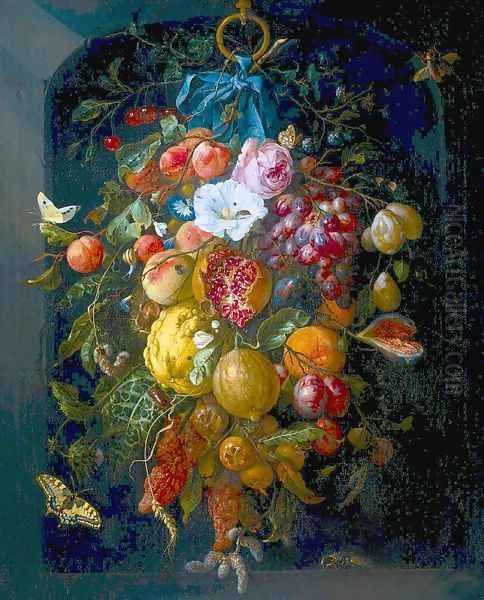
Around 1625, De Heem moved to Leiden, a vibrant center of art and learning. He resided there for approximately four years, until 1629. During this period, his artistic style continued to evolve. He absorbed influences from the local artistic milieu, including further inspiration from Balthasar van der Ast and potentially from the Leiden 'fijnschilders' (fine painters). Sources also suggest a brief period of study or interaction with David Bailly, another significant Leiden artist known for his portraits and vanitas still lifes. The impact of painters like Pieter Claesz. and Willem Claesz. Heda, masters of the monochrome 'banketje' (banquet piece), can also be seen in the subdued palettes and compositional structures of some of his Leiden-period works.
Flourishing in Antwerp: The Development of a Luxurious Style
After his formative years in Leiden, De Heem returned briefly to Utrecht around 1626 before making a pivotal move to Antwerp in 1631. Antwerp, a major artistic hub in the Southern Netherlands (Flanders), offered a different cultural and artistic environment compared to the Calvinist Dutch Republic. Here, the opulent Flemish Baroque style, heavily influenced by masters like Peter Paul Rubens, held sway. De Heem quickly integrated into the city's artistic life, becoming a master in the prestigious Guild of Saint Luke in the guild year 1635-1636. He further solidified his connection to the city by becoming a burgher (citizen) of Antwerp in 1637.
It was in Antwerp that De Heem's signature style truly blossomed. He moved away from the more restrained, monochromatic still lifes associated with Leiden and embraced the richness and dynamism of the Flemish tradition. His compositions became more elaborate, his colors more vibrant, and his subject matter increasingly focused on displays of luxury and abundance. This shift marked the development of the 'pronkstilleven' (ostentatious or sumptuous still life), a genre with which De Heem would become inextricably linked. His Antwerp period, particularly between 1635 and 1665, is considered his most productive and artistically significant phase, yielding numerous high-quality works.
While Antwerp remained his primary base for much of his mature career, De Heem maintained connections with Utrecht. Records indicate he spent time back in his birth city between 1649 and 1652, and again for a longer period from 1667 until 1672, possibly fleeing the advancing French armies during the Franco-Dutch War. However, he eventually returned to Antwerp, where he spent his final years.
The Art of Jan Davidsz. de Heem
De Heem's artistry is characterized by an extraordinary ability to render diverse objects with stunning realism, combined with a sophisticated sense of composition and color.
Signature Style and Subjects
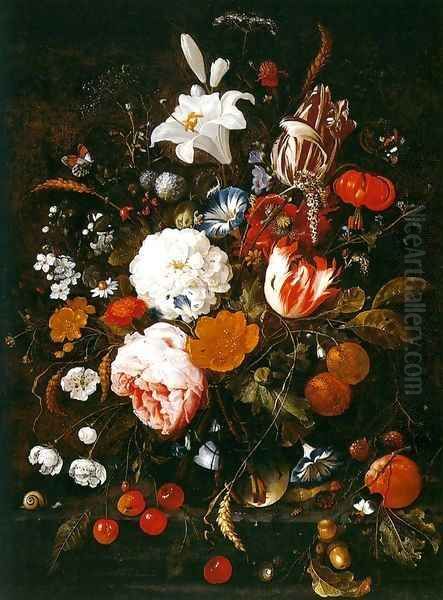
De Heem is best known for his 'pronkstillevens'. These paintings typically feature lavish arrangements of expensive objects: gleaming silver and gold vessels, intricate glassware often filled with wine, imported fruits like lemons and grapes depicted with glistening peels, exotic shells, luxurious textiles, musical instruments, and books. Flowers, rendered with botanical accuracy and vibrant color, were another favorite subject, often arranged in elaborate bouquets within glass or ceramic vases. His skill in capturing different textures – the softness of a peach, the coolness of metal, the transparency of glass, the delicate structure of a flower petal – was unparalleled. He often included small details like insects (butterflies, flies, snails) crawling over the objects, adding a touch of life and naturalism, while also potentially carrying symbolic weight. His compositions, though seemingly casual arrangements, were carefully constructed to create visual harmony and often a sense of dynamic movement through diagonal lines and contrasting forms.
Symbolism and Meaning
Beyond their surface beauty and celebration of wealth, De Heem's still lifes are often imbued with deeper symbolic meanings, reflecting the moral and religious concerns of the 17th century. The inclusion of elements like skulls, hourglasses, snuffed candles, or watches served as 'memento mori' – reminders of the transience of life, the inevitability of death, and the vanity of worldly pleasures. This 'vanitas' theme was particularly prevalent in Dutch art following the Protestant Reformation. Partially peeled lemons could symbolize the deceptive allure of earthly beauty, sweet on the outside but sour within. Grapes and wine often carried Eucharistic connotations, referencing the blood of Christ. Even the presence of insects could symbolize decay or the fleeting nature of existence. While celebrating abundance, his works simultaneously cautioned viewers against excessive attachment to material possessions.
Representative Masterpieces
Several works exemplify De Heem's mastery:
_Still Life with a Table of Desserts_ (also referred to as _Festoon of Fruit and Flowers_ or similar titles, c. 1640): A quintessential example of his Antwerp style, this large canvas (often cited as being in the Louvre) presents a sumptuous table laden with fruit, oysters, a partly peeled lemon, elaborate goblets, and musical instruments. It showcases his ability to handle complex compositions and render diverse textures under dramatic lighting, embodying both luxury and underlying moral commentary.
_Still Life with Flowers in a Glass Vase_ (c. 1650-1660): Demonstrating his skill with floral subjects, works like this depict lush bouquets featuring a variety of flowers at their peak bloom, meticulously rendered within a transparent glass vase. The play of light on the glass and water, alongside the vibrant petals, highlights his technical virtuosity. Examples can be found in various museum collections.
_Vanitas Still-Life_ (various examples, e.g., c. 1650s): De Heem produced several works explicitly focused on the vanitas theme. These often feature a skull prominently displayed alongside objects like books, musical instruments, extinguished candles, or timepieces, directly confronting the viewer with reminders of mortality and the fleeting nature of human pursuits and knowledge.
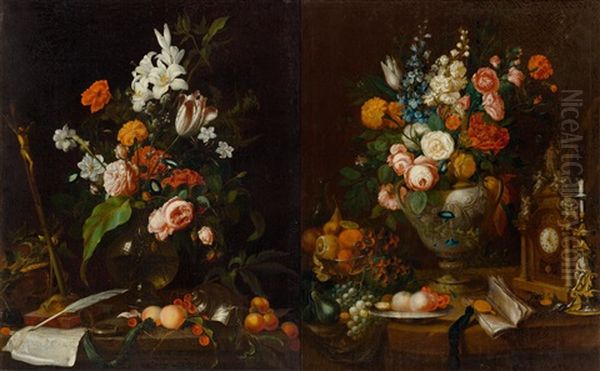
_Still Life with Fruit and Flowers in an Archway_ (c. 1650s): In some compositions, De Heem employed architectural elements like stone archways or niches. These features not only added compositional structure but also enhanced the sense of depth and created a more theatrical presentation of the still life elements arranged within or before them.
_Still Life with Oysters and Grapes_ (1653): This work highlights his ability to capture the specific textures and appearances of foodstuffs, from the glistening interior of oysters to the translucent skin of grapes, arranged alongside glassware and other common still life elements.
His paintings are housed in major international museums, including the Rijksmuseum in Amsterdam, the Mauritshuis in The Hague, the National Gallery in London, the Louvre in Paris, the Royal Museums of Fine Arts of Belgium in Brussels, and the Metropolitan Museum of Art in New York, among many others.
Relationships and Collaborations
De Heem's career was interwoven with the artistic networks of his time. His primary teachers, Balthasar van der Ast and potentially David Bailly, provided foundational training. In Antwerp, he entered a milieu dominated by the influence of Peter Paul Rubens, whose dynamic Baroque style impacted the general artistic climate.
De Heem is known to have collaborated directly with other Antwerp artists. Figures were sometimes added to his still lifes by painters such as Erasmus Quellinus II. Documents also suggest interactions or collaborations with artists like Marten Kretzer and Willem Boerschap. His work shows affinities with, and likely mutual influence between him and, other prominent Antwerp still life specialists like Frans Snyders, known for his large market scenes and hunting pieces, Daniel Seghers, famous for his flower cartouches often surrounding religious scenes painted by others, and Adriaen van Utrecht.
Interestingly, one source mentions collaborations with Pieter Potter (father of the more famous Paulus Potter) and even Rembrandt van Rijn. While collaboration with Rembrandt seems less documented than his Antwerp connections, any interaction between these two giants of the Dutch Golden Age would be significant, highlighting De Heem's standing within the broader Dutch art scene.
Family, Students, and Personal Life
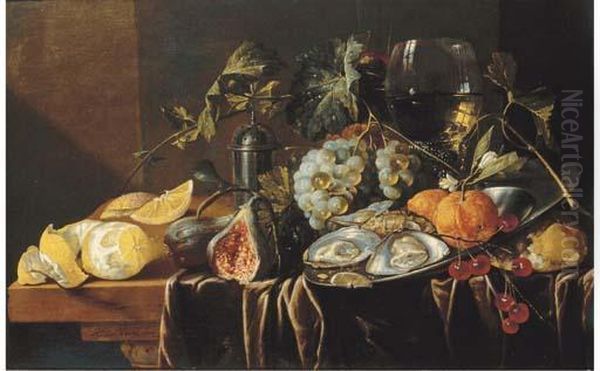
Jan Davidsz. de Heem married Aletta van Weede in Utrecht in 1626 (some sources suggest 1625). They had at least three children documented: Maria Anna (born 1626), Hildegard (born 1628), and Johannes (born 1630), who sadly seems to have died young. Aletta passed away in 1634. A peculiar anecdote survives concerning Aletta: she was reportedly involved in a complex marriage plot with a baker named Cornelis van Oostwaert, attempting to manipulate De Heem into marrying another woman, a scheme that ultimately failed.
Following Aletta's death, De Heem remarried in Antwerp in 1643 (or possibly early 1644) to Anna Ruckers, daughter of the famous harpsichord maker Andreas Ruckers the Elder. This marriage connected him to a prominent family of artisans. With Anna, he had several more children, including Cornelis de Heem (born 1631 - note: birth year predates marriage to Anna, suggesting he might be Aletta's son, or records are complex), who became a notable still life painter in his own right, closely following his father's style.
De Heem was not only a prolific painter but also an influential teacher. His studio attracted numerous pupils and followers who sought to emulate his successful style. Besides his son Cornelis, another family member, possibly his younger brother or another son named Jan Janszoon de Heem, also became a painter working in a similar vein. Other documented pupils or close followers include Alexander Coosemans, Thomas de Klerck, Lenaert Leys, Theodoor Aenvanck, Andries Benedetti, Elias van den Broeck, Jacob Marrel (who later taught Abraham Mignon), and Maria van Oosterwijck. Through his students and imitators, De Heem's style proliferated across the Netherlands and beyond.
Later Life, Reputation, and Legacy
De Heem remained active as an artist into his later years, although his health reportedly declined towards the end of his life. He passed away in Antwerp in 1684, likely between January and April 26, leaving behind a substantial body of work and a significant artistic legacy.
During his lifetime, De Heem achieved considerable fame and financial success. His paintings were highly sought after by collectors across Europe and commanded high prices, sometimes reportedly exceeding those paid for works by Rembrandt. His reputation was built on his technical brilliance, the appealing richness of his subjects, and the underlying intellectual depth provided by the symbolic elements.
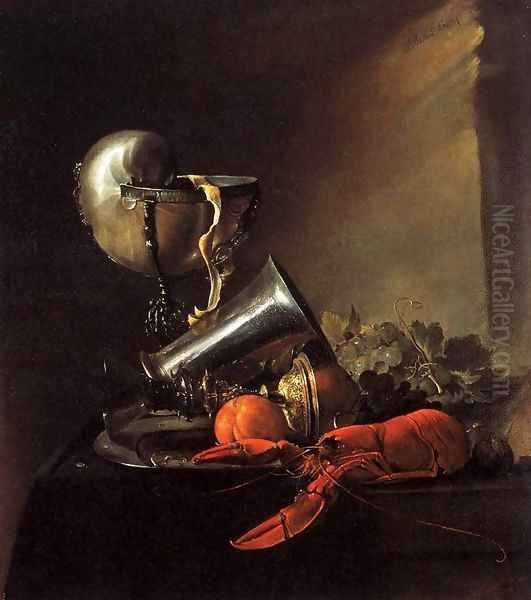
His influence extended far beyond his immediate circle of students. He is considered a foundational figure in the development of the Baroque still life in both the Dutch Republic and Flanders. His fusion of Dutch meticulousness with Flemish dynamism and opulence created a powerful and enduring style. The genre of the 'pronkstilleven' owes much of its development and popularity to his pioneering work. Later generations of still life painters continued to draw inspiration from his compositions, techniques, and thematic concerns. Some sources even suggest a line of influence extending to modern artists like Paul Cézanne and Henri Matisse, who explored the formal qualities of still life, though the directness of this connection requires careful consideration.
Unresolved Questions and Controversies
Despite his fame, aspects of De Heem's life and work remain subject to debate and scholarly investigation:
Attribution Issues: De Heem's success led to numerous imitations and copies, both during his lifetime and afterward. Many works of lesser quality, or works by his sons, students, or followers, have been incorrectly attributed to him over the centuries. This "pollution" of his oeuvre makes establishing a definitive catalogue raisonné challenging, requiring careful connoisseurship and technical analysis to distinguish the master's hand.
Signatures and Dates: A significant portion of De Heem's work lacks clear signatures or dates, particularly after his earlier period. While he used various forms of signature, including monograms (like J. De Heem f.), their absence or ambiguity on many paintings complicates dating and attribution. Art historian Fred G. Meijer has noted the apparent disappearance of a specific monogram signature after 1640, adding to the complexity.
Early Style Evolution: The marked difference between his more restrained Leiden-period works and the exuberant style he developed in Antwerp has led to ongoing discussion about the precise trajectory of his early development and the attribution of certain transitional pieces.
Symbolism Interpretation: While the general meaning of common vanitas symbols is understood, the specific connotations of certain objects or combinations in his paintings can be elusive. The precise meaning intended by De Heem for elements like the arrow and wine mentioned in relation to a specific work ('A 129' in one source) may remain speculative, potentially understood fully only by the artist and his contemporary audience.
Technical Details: Minor technical aspects, such as the occasional appearance of small white spots on the paint surface of some works, have sparked debate about whether they represent intentional artistic effects, accidental flaws, or later alterations.
Birthplace and Identity: While generally accepted as born in Utrecht, some scholarly sources have questioned this, occasionally suggesting an Antwerp origin based on his name ('van Antwerpen') or other interpretations of archival records. This remains a point of minor controversy.
Conclusion
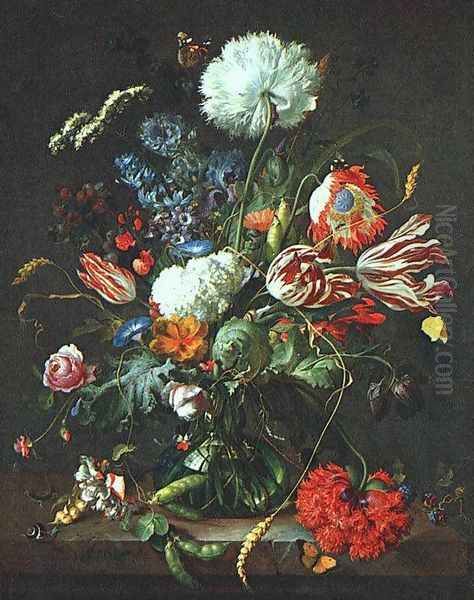
Jan Davidsz. de Heem remains a pivotal figure in the history of European art, particularly within the specialized yet profoundly rich genre of still life painting. His journey from Utrecht to Leiden and finally to Antwerp mirrored a stylistic evolution from restrained Dutch realism to exuberant Flemish Baroque display. He mastered the art of the 'pronkstilleven', creating visually stunning compositions that celebrated material beauty while simultaneously embedding complex layers of moral and religious symbolism. His technical brilliance in rendering diverse textures, his sophisticated use of color and light, and his influential role as a teacher cemented his reputation. Despite ongoing scholarly debates surrounding attribution and interpretation, De Heem's legacy endures through his magnificent paintings, which continue to captivate audiences with their intricate detail, luxurious appeal, and enduring reflections on life, death, and vanity. He was, without doubt, one of the true masters of the Dutch Golden Age.